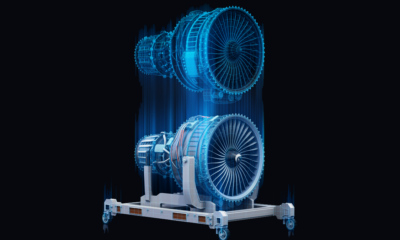TECHNOLOGY
Who Knew Lights-Out Manufacturing Needed Lights-On Communication?

The first industrial revolution in the 1700s brought about the mechanization of manufacturing processes.
Water and steam power were harnessed to dawn in the era of mechanized manufacturing. Then, the second industrial revolution introduced assembly lines and increased manufacturing output with the help of electricity. The third revolution was brought on by the adoption of computers in manufacturing processes. Each of these three revolutions was significant and improved manufacturing by leaps and bounds. However, they still relied on human labor. However, things are about to change drastically with the fourth industrial revolution or Industry 4.0. Let us introduce you to smart factories that are going to be the defining element of Industry 4.0. Factories will have IoT-based connected machines with machine learning capabilities that will communicate with each other. This will help us automate manufacturing tasks and achieve true automation in manufacturing, termed as ‘lights-out’ manufacturing, with LiFi playing a pivotal role in industrial automation.
What Is Lights-Out Manufacturing?
Lights-out manufacturing is a manufacturing methodology that requires no human presence on factory floors to carry out the manufacturing processes. The factories operate fully automated and the term, ‘lights-out’ is adopted from the concept that factories don’t need the lights on for a robotic operation. Historically, lights-out manufacturing factories have been difficult to implement and have produced limited results. Why? Because manufacturing processes are complex and require a high degree of flexibility. It is usually believed that manufacturing is a straightforward process and is dull and repetitive. On the contrary, it requires enormous amounts of skills, planning, and management. For example, manufacturing processes involve precision, decision-making, and sensitivity that are currently difficult for machine learning algorithms to replicate. Then, there is a major hurdle in the form of data delivery. A delay in communication can lead to the failure of an entire batch of manufactured products and set you back on your schedule and finances. Hence, achieving fully automated manufacturing is still a distant reality. However, with advancements in technology, we are slowly inching closer to achieving lights out manufacturing. Take the example of Philips lights-out factory in the Netherlands. The factory uses 128 robots to manufacture electric razors in a fully automated process. The factory has just nine human quality assurance employees who oversee the final step of the manufacturing process. In this blog, we have discussed the data transmission hurdles currently faced in manufacturing and how the use of LiFi for industrial automation can help us achieve our goal of truly automated manufacturing plants.
What Are The Current Data Delivery Challenges Faced In Industrial Automation?
The current data transmission technologies rely on radio-frequency waves. Theoretically, we can achieve speeds up to 600 Mb/s and 1300 Mb/s using RF technology. However, the actual data speeds are much lower than theoretical speeds. This leads to high latency issues, which can cause communication delays. Machines can’t be reliably operated with such networks, hence becoming a bottleneck for achieving lights-out manufacturing. For instance, if there is a delay in communication between machines, the assembly lines may malfunction, resulting in errors in the assembled product, leading to losses.
Then, there are security challenges to mitigate. Radio-based networks can be hacked remotely, which can cause data leakages or catastrophic machine failures. Additionally, radio-based frequencies cannot be used in hostile environments such as in petrochemical industries or areas having too much interference. To mitigate most of these challenges, 5G is being explored as a replacement for current network connectivity. Agreed that 5G provides higher speeds than 4G, but since 5G, too, is RF-based, shares most of the challenges faced, and proves to be a non-viable option. Additionally, 5G requires a lot of infrastructural setups as the waves travel short distances, and deploying a 5G solution may cost exorbitant amounts of money, which is not feasible for most factories. So, is there a solution to the challenges? Yes. LiFi. LiFi appears to be a viable option for meeting the data transmission speed and security requirements in lights-out manufacturing as it ticks almost every box required for achieving lights-out manufacturing.
What Is LiFi?
LiFi is a wireless data transmission technology that makes use of visible light to transmit and receive data. A transmitting source, such as a LED light bulb, emits light pulses containing the data that needs to be transmitted. The receivers collect the transmitted information and interpret the data. The light pulses are, however, undetectable to the human eye. The concept is similar to Morse code, but the data transmission is at a much faster rate.
How Can LiFi Help Us Achieve True Lights-Out Manufacturing?
Using LiFi for industrial automation provides a plethora of benefits and helps us take a step closer to achieving true manufacturing automation.
LiFi technology provides a broad bandwidth for data transmission with high transmission speeds. The theoretical transmission speeds can go over 100Gbps, which is fourteen times faster than the fastest WiFi we know today. Thus, LiFi can help us achieve real-time communication between machines employed at manufacturing plants, significantly improving the manufacturing process’s efficacy. The machines can work in tandem with each other as a single cohesive unit with zero communication delay, resulting in higher productivity and significantly improving the production quality.
Additionally, with LiFi networks, there is no network interference or saturation experienced, unlike radio-frequency signals, where several data sources can disrupt the network’s functioning. This ensures seamless communication between the machinery with very low latency and zero data loss, which is crucial for complex manufacturing processes. With uninterrupted, real-time communication and zero interference, machines can autonomously work with higher reliability, automation, and speed. Using LiFi for industrial automation also helps with machinery maintenance procedures. With real-time monitoring made possible by LiFi, engineers can quickly identify errors that may occur during production and take corrective actions. This contributes to improving the lifespan and the reliability of the machines and helps reduce machine maintenance and operating costs. There are additional cost savings with LiFi as the LiFi hardware acts as a light source and a data transmission source.
Another benefit of using LiFi for industrial automation is that it provides enhanced security. While RF signals can penetrate through walls and most objects, LiFi signals are blocked by walls, and hence a hacker will need to be physically present inside the manufacturing plant to carry out a hacking attack. Additionally, you can incorporate the existing encryption and authentication security protocols into LiFi systems to further secure your wireless network. You can thus keep factories running without any worries of your network being compromised as long as your LiFi network is physically contained.
Another advantage of using LiFi for industrial automation is that, unlike WiFi, LiFi can be used in environments that are hazardous for radio frequencies. For example, the petrochemical and power generation industries can’t use RF for communication. Petrochemical products are highly sensitive to RF waves. Similarly, the power generation sector can’t use RF due to interference issues. However, LiFi faces no such challenges and can easily be deployed to provide wireless connectivity without any safety threat.
Benefits of Using LiFi for Industry 4.0
1. Increased automation: Using LiFi for industrial automation provides fast, secure and reliable network connectivity with low latency that can help various components of the manufacturing floor communicate with each other seamlessly. Takeaway: Eliminates the need for factory floor workers.
2. Improved maintenance: LiFi, combined with machine learning in the manufacturing sector, can help transition from reactive to predictive maintenance, significantly reducing machine downtime and maintenance costs. Takeaway: Machines can be repaired well ahead of time, helping save costs. In the future, automated robots can be deployed to replace parts.
3. Enhanced security: Since LiFi connections are limited to the physical space that the light touches, it leads to enhanced security levels as outside attacks aren’t possible with LiFi. Takeaway: Manufacturing units can be set to operate autonomously without the fear of the network getting compromised. Technologies such as machine learning and artificial intelligence can be used to enhance security further.
4. Improved decision making: As accurate data is available in real-time with LiFi connections, businesses can make better decisions by analyzing it. Takeaway: A machinery chain with machine learning capabilities can analyze various data metrics and make adjustments automatically to maximize the manufacturing process’s efficiency. Therefore, with these benefits, we can bet that LiFi can usher in an era of true automation in the manufacturing sector.
LiFi technology is still in its nascent stages. However, with further research and development in LiFi and other essential technologies for smart factories, LiFi will play a pivotal role in data communication that will help these smart factories to function. We believe that using LiFi for industrial automation will be the future. For that, we can start working now for developing smart factories with LiFi in mind instead of 4G or 5G as the preferred communications technology. Lights-out manufacturing will surely need a ‘lights-on communication approach, and we need to start taking steps in that direction now.
Source link
TECHNOLOGY
Next-gen chips, Amazon Q, and speedy S3

AWS re:Invent, which has been taking place from November 27 and runs to December 1, has had its usual plethora of announcements: a total of 21 at time of print.
Perhaps not surprisingly, given the huge potential impact of generative AI – ChatGPT officially turns one year old today – a lot of focus has been on the AI side for AWS’ announcements, including a major partnership inked with NVIDIA across infrastructure, software, and services.
Yet there has been plenty more announced at the Las Vegas jamboree besides. Here, CloudTech rounds up the best of the rest:
Next-generation chips
This was the other major AI-focused announcement at re:Invent: the launch of two new chips, AWS Graviton4 and AWS Trainium2, for training and running AI and machine learning (ML) models, among other customer workloads. Graviton4 shapes up against its predecessor with 30% better compute performance, 50% more cores and 75% more memory bandwidth, while Trainium2 delivers up to four times faster training than before and will be able to be deployed in EC2 UltraClusters of up to 100,000 chips.
The EC2 UltraClusters are designed to ‘deliver the highest performance, most energy efficient AI model training infrastructure in the cloud’, as AWS puts it. With it, customers will be able to train large language models in ‘a fraction of the time’, as well as double energy efficiency.
As ever, AWS offers customers who are already utilising these tools. Databricks, Epic and SAP are among the companies cited as using the new AWS-designed chips.
Zero-ETL integrations
AWS announced new Amazon Aurora PostgreSQL, Amazon DynamoDB, and Amazon Relational Database Services (Amazon RDS) for MySQL integrations with Amazon Redshift, AWS’ cloud data warehouse. The zero-ETL integrations – eliminating the need to build ETL (extract, transform, load) data pipelines – make it easier to connect and analyse transactional data across various relational and non-relational databases in Amazon Redshift.
A simple example of how zero-ETL functions can be seen is in a hypothetical company which stores transactional data – time of transaction, items bought, where the transaction occurred – in a relational database, but use another analytics tool to analyse data in a non-relational database. To connect it all up, companies would previously have to construct ETL data pipelines which are a time and money sink.
The latest integrations “build on AWS’s zero-ETL foundation… so customers can quickly and easily connect all of their data, no matter where it lives,” the company said.
Amazon S3 Express One Zone
AWS announced the general availability of Amazon S3 Express One Zone, a new storage class purpose-built for customers’ most frequently-accessed data. Data access speed is up to 10 times faster and request costs up to 50% lower than standard S3. Companies can also opt to collocate their Amazon S3 Express One Zone data in the same availability zone as their compute resources.
Companies and partners who are using Amazon S3 Express One Zone include ChaosSearch, Cloudera, and Pinterest.
Amazon Q
A new product, and an interesting pivot, again with generative AI at its core. Amazon Q was announced as a ‘new type of generative AI-powered assistant’ which can be tailored to a customer’s business. “Customers can get fast, relevant answers to pressing questions, generate content, and take actions – all informed by a customer’s information repositories, code, and enterprise systems,” AWS added. The service also can assist companies building on AWS, as well as companies using AWS applications for business intelligence, contact centres, and supply chain management.
Customers cited as early adopters include Accenture, BMW and Wunderkind.
Want to learn more about cybersecurity and the cloud from industry leaders? Check out Cyber Security & Cloud Expo taking place in Amsterdam, California, and London. Explore other upcoming enterprise technology events and webinars powered by TechForge here.
TECHNOLOGY
HCLTech and Cisco create collaborative hybrid workplaces

Digital comms specialist Cisco and global tech firm HCLTech have teamed up to launch Meeting-Rooms-as-a-Service (MRaaS).
Available on a subscription model, this solution modernises legacy meeting rooms and enables users to join meetings from any meeting solution provider using Webex devices.
The MRaaS solution helps enterprises simplify the design, implementation and maintenance of integrated meeting rooms, enabling seamless collaboration for their globally distributed hybrid workforces.
Rakshit Ghura, senior VP and Global head of digital workplace services, HCLTech, said: “MRaaS combines our consulting and managed services expertise with Cisco’s proficiency in Webex devices to change the way employees conceptualise, organise and interact in a collaborative environment for a modern hybrid work model.
“The common vision of our partnership is to elevate the collaboration experience at work and drive productivity through modern meeting rooms.”
Alexandra Zagury, VP of partner managed and as-a-Service Sales at Cisco, said: “Our partnership with HCLTech helps our clients transform their offices through cost-effective managed services that support the ongoing evolution of workspaces.
“As we reimagine the modern office, we are making it easier to support collaboration and productivity among workers, whether they are in the office or elsewhere.”
Cisco’s Webex collaboration devices harness the power of artificial intelligence to offer intuitive, seamless collaboration experiences, enabling meeting rooms with smart features such as meeting zones, intelligent people framing, optimised attendee audio and background noise removal, among others.
Want to learn more about cybersecurity and the cloud from industry leaders? Check out Cyber Security & Cloud Expo taking place in Amsterdam, California, and London. Explore other upcoming enterprise technology events and webinars powered by TechForge here.
TECHNOLOGY
Canonical releases low-touch private cloud MicroCloud

Canonical has announced the general availability of MicroCloud, a low-touch, open source cloud solution. MicroCloud is part of Canonical’s growing cloud infrastructure portfolio.
It is purpose-built for scalable clusters and edge deployments for all types of enterprises. It is designed with simplicity, security and automation in mind, minimising the time and effort to both deploy and maintain it. Conveniently, enterprise support for MicroCloud is offered as part of Canonical’s Ubuntu Pro subscription, with several support tiers available, and priced per node.
MicroClouds are optimised for repeatable and reliable remote deployments. A single command initiates the orchestration and clustering of various components with minimal involvement by the user, resulting in a fully functional cloud within minutes. This simplified deployment process significantly reduces the barrier to entry, putting a production-grade cloud at everyone’s fingertips.
Juan Manuel Ventura, head of architectures & technologies at Spindox, said: “Cloud computing is not only about technology, it’s the beating heart of any modern industrial transformation, driving agility and innovation. Our mission is to provide our customers with the most effective ways to innovate and bring value; having a complexity-free cloud infrastructure is one important piece of that puzzle. With MicroCloud, the focus shifts away from struggling with cloud operations to solving real business challenges” says
In addition to seamless deployment, MicroCloud prioritises security and ease of maintenance. All MicroCloud components are built with strict confinement for increased security, with over-the-air transactional updates that preserve data and roll back on errors automatically. Upgrades to newer versions are handled automatically and without downtime, with the mechanisms to hold or schedule them as needed.
With this approach, MicroCloud caters to both on-premise clouds but also edge deployments at remote locations, allowing organisations to use the same infrastructure primitives and services wherever they are needed. It is suitable for business-in-branch office locations or industrial use inside a factory, as well as distributed locations where the focus is on replicability and unattended operations.
Cedric Gegout, VP of product at Canonical, said: “As data becomes more distributed, the infrastructure has to follow. Cloud computing is now distributed, spanning across data centres, far and near edge computing appliances. MicroCloud is our answer to that.
“By packaging known infrastructure primitives in a portable and unattended way, we are delivering a simpler, more prescriptive cloud experience that makes zero-ops a reality for many Industries.“
MicroCloud’s lightweight architecture makes it usable on both commodity and high-end hardware, with several ways to further reduce its footprint depending on your workload needs. In addition to the standard Ubuntu Server or Desktop, MicroClouds can be run on Ubuntu Core – a lightweight OS optimised for the edge. With Ubuntu Core, MicroClouds are a perfect solution for far-edge locations with limited computing capabilities. Users can choose to run their workloads using Kubernetes or via system containers. System containers based on LXD behave similarly to traditional VMs but consume fewer resources while providing bare-metal performance.
Coupled with Canonical’s Ubuntu Pro + Support subscription, MicroCloud users can benefit from an enterprise-grade open source cloud solution that is fully supported and with better economics. An Ubuntu Pro subscription offers security maintenance for the broadest collection of open-source software available from a single vendor today. It covers over 30k packages with a consistent security maintenance commitment, and additional features such as kernel livepatch, systems management at scale, certified compliance and hardening profiles enabling easy adoption for enterprises. With per-node pricing and no hidden fees, customers can rest assured that their environment is secure and supported without the expensive price tag typically associated with cloud solutions.
Want to learn more about cybersecurity and the cloud from industry leaders? Check out Cyber Security & Cloud Expo taking place in Amsterdam, California, and London. Explore other upcoming enterprise technology events and webinars powered by TechForge here.
-

 PPC5 days ago
PPC5 days agoA History of Google AdWords and Google Ads: Revolutionizing Digital Advertising & Marketing Since 2000
-

 SEARCHENGINES6 days ago
SEARCHENGINES6 days agoMore Google March 2024 Core Update Ranking Volatility
-

 PPC6 days ago
PPC6 days agoCompetitor Monitoring: 7 ways to keep watch on the competition
-

 PPC6 days ago
PPC6 days ago31 Ready-to-Go Mother’s Day Messages for Social Media, Email, & More
-

 WORDPRESS6 days ago
WORDPRESS6 days agoThrive Architect vs Divi vs Elementor
-

 WORDPRESS5 days ago
WORDPRESS5 days agoTurkish startup ikas attracts $20M for its e-commerce platform designed for small businesses
-

 MARKETING4 days ago
MARKETING4 days agoRoundel Media Studio: What to Expect From Target’s New Self-Service Platform
-

 MARKETING6 days ago
MARKETING6 days agoHow To Adapt Your SEO and Content Strategies for SGE and AI Experiences
















You must be logged in to post a comment Login